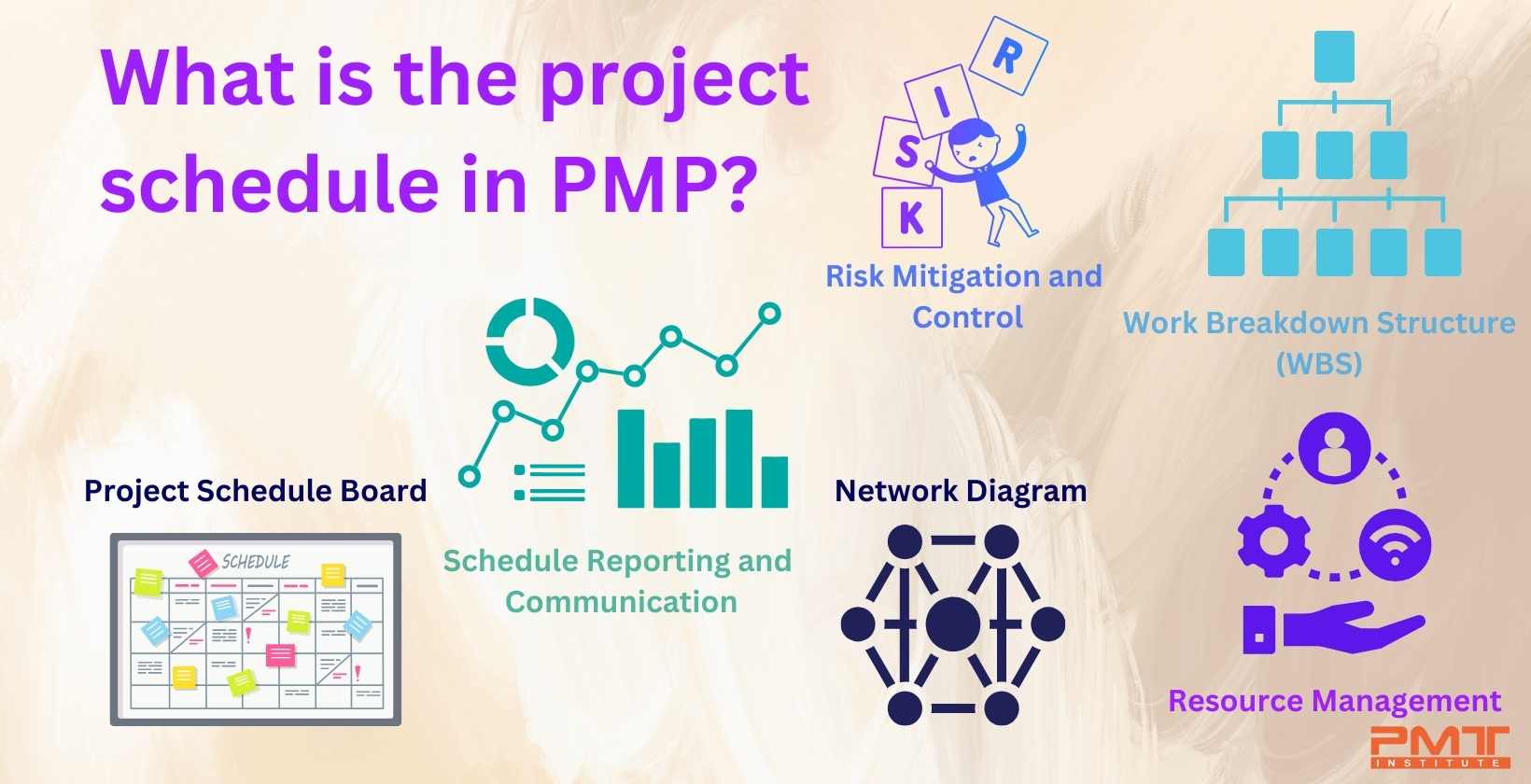What is the project schedule in PMP?
Published:
Updated:

A well-crafted and meticulously executed project schedule is an indispensable tool for project success. The Project Management Institute (PMI) emphasizes the significance of project schedules as a critical component of project planning and control. A project schedule outlines the timeline for executing project activities, helping project managers and teams stay on track, manage resources efficiently, and deliver the project within the specified timeframe.
In this detailed blog, we will delve into the intricacies of project schedules in the context of the Project Management Professional (PMP) certification, offering valuable insights and a comprehensive resource for project managers seeking to excel in their project planning endeavors.
Definition of Project Schedule
The project schedule, as defined in the PMP framework, is a time-bound plan that outlines the start and finish dates for each project activity. It serves as a roadmap for the project team, detailing when and in what sequence specific tasks must be completed to achieve project objectives. A well-constructed project schedule factors in the logical dependencies between activities, resource availability, and various constraints to ensure an efficient and effective project timeline.
Importance of Project Schedule in PMP
The project schedule plays a pivotal and multifaceted role in the successful execution of projects within the Project Management Professional (PMP) framework. As a fundamental element of project planning and control, the project schedule holds immense importance in guiding project teams towards achieving project objectives and delivering value to stakeholders.
Strategic Planning and Direction
The project schedule acts as a strategic planning tool, providing a clear roadmap that outlines the sequence and timelines for project activities. With a well-defined schedule, project managers can chart the course of action, allocate resources effectively, and set realistic milestones to track progress. It offers a blueprint that not only streamlines project execution but also ensures that the project remains focused on its goals and objectives.
Resource Management
Efficient resource management is essential for project success, and the project schedule plays a crucial role in optimizing resource allocation. By having a comprehensive schedule that outlines when specific resources are needed, project managers can avoid overburdening certain team members while ensuring that all resources are utilized efficiently. This helps maintain a balanced workload, enhances productivity, and minimizes resource bottlenecks.
Time Management
Time is a precious commodity in project management, and adhering to project timelines is vital to meeting client expectations and organizational goals. The project schedule acts as a time management tool, empowering project managers to identify critical path activities and allocate resources accordingly. This ensures that the project progresses as per plan, mitigating delays and delivering the project on schedule.
Risk Mitigation and Control
A well-developed project schedule incorporates contingency planning and project risk management. By identifying critical path activities and potential bottlenecks, project managers can proactively address risks and develop mitigation strategies. Regularly monitoring project progress against the schedule baseline allows for early detection of deviations, enabling timely interventions to keep the project on track.
Stakeholder Communication and Engagement
The project schedule serves as a central communication tool, facilitating clear and transparent communication with stakeholders. By sharing the schedule, project managers keep stakeholders informed about project timelines, deliverables, and progress. Effective communication fosters stakeholder engagement and buy-in, strengthening the overall project team's collaboration and commitment to project success.
Decision-Making and Course Correction
With a well-defined project schedule, project managers are equipped with valuable data for data-driven decision-making. Project performance against the schedule baseline provides insights into the project's health, allowing project managers to identify trends, potential issues, and areas that require attention. Based on this information, informed decisions can be made to course-correct if necessary, enhancing the project's chances of success.
Adapting to Change
In today's dynamic business environment, change is inevitable. A robust project schedule enables project teams to adapt to changing circumstances effectively. When unforeseen events occur, the project schedule can be updated and adjusted accordingly, ensuring that the project remains aligned with its objectives and continues to move forward despite the challenges.
Role of Project Schedule in Project Management
The project schedule in project management acts as a central point for project planning, communication, and control. It facilitates effective resource allocation, task sequencing, and risk mitigation, ensuring that the project is progressing according to plan and that deviations are promptly addressed.
Benefits of Creating a Well-Structured Project Schedule
A well-structured project schedule offers several benefits, such as:
Clarity: Clearly defined timelines help project teams understand project milestones and deadlines, fostering a sense of direction and purpose.
Efficiency: Efficient resource allocation ensures that resources are utilized optimally, reducing wastage and promoting productivity.
Accountability: A clear project schedule assigns responsibilities and accountabilities, encouraging team members to take ownership of their tasks.
Risk Management: By identifying critical path activities and dependencies, project managers can proactively manage risks and potential delays.
Creating a Project Schedule
Work Breakdown Structure (WBS)
The foundation of a project schedule lies in the development of a comprehensive Work Breakdown Structure (WBS). The WBS breaks down the project scope into smaller, manageable components, known as work packages. Each work package represents a specific deliverable or task, enabling project managers to allocate resources, estimate durations, and identify dependencies accurately.
Network Diagrams
Once the WBS is established, project managers use network diagrams, such as the Precedence Diagramming Method (PDM) or the Arrow Diagramming Method (ADM), to visualize the logical relationships between project activities. Network diagrams show the flow of activities and the dependencies that dictate the sequence in which tasks must be performed.
Estimating Activity Durations
Accurate estimation of activity durations is crucial for developing a realistic project schedule. PMP-certified project managers employ various techniques, such as expert judgment, analogous estimating, parametric estimating, and three-point estimating (optimistic, pessimistic, and most likely), to determine how long each activity will take to complete.
Critical Path Method (CPM)
In the PMP context, the Critical Path Method (CPM) is a fundamental technique used to determine the project's critical path – the longest sequence of activities that determines the project's minimum duration. Activities on the critical path have zero float, meaning any delay in these tasks will result in a corresponding delay in the project's overall completion time.
Schedule Compression Techniques
Project schedules are often subject to time constraints. Project managers may use schedule compression techniques, such as crashing and fast-tracking, to expedite project timelines without compromising quality. Crashing involves adding additional resources to critical path activities, while fast-tracking involves overlapping certain activities that were originally scheduled sequentially.
Resource Leveling
Resource leveling is a technique employed to optimize resource allocation and avoid overburdening resources during project execution. By smoothing out resource utilization, project managers ensure a balanced workload and maintain project productivity without causing resource bottlenecks.
Schedule Baseline and Control
Schedule Baseline
The schedule baseline is a critical component of project schedule management. It represents the approved, time-bound version of the project schedule against which project performance will be measured. Any changes to the schedule must undergo a formal change control process to update the schedule baseline.
Schedule Control
Once the project is underway, project managers engage in schedule control to monitor and manage project progress. Regularly comparing actual progress with the schedule baseline allows project managers to identify deviations, assess the impact of changes, and take corrective actions to keep the project on track.
Monitoring Project Progress
Project managers monitor project progress through various tools and techniques, such as milestone tracking, status reports, and earned value analysis. These monitoring mechanisms enable project managers to identify variances, address potential issues, and make data-driven decisions.
Schedule Variance and Performance Indices
Schedule variance (SV) measures the difference between the planned progress and the actual progress of the project. A positive SV indicates that the project is ahead of schedule, while a negative SV signals a delay. The Schedule Performance Index (SPI) represents the efficiency of schedule performance concerning the budgeted time. An SPI greater than 1 indicates that the project is ahead of schedule, while an SPI less than 1 suggests a delay.
Schedule Reporting and Communication
Visual Reports
Effective schedule reporting involves using visual aids such as Gantt charts, milestone charts, and earned value graphs to present project progress to stakeholders in a clear and concise manner. Visual reports facilitate easy comprehension and aid decision-making.
Stakeholder Communication
Project managers regularly communicate schedule updates and progress to stakeholders, fostering transparency and ensuring that all parties are informed about the project's status. Effective communication strengthens stakeholder engagement and buy-in.
Project Schedule Updates and Change Control
As the project progresses, project managers may need to update the project schedule to reflect changes in scope, resources, or external factors. Any schedule changes must undergo a formal change control process to maintain consistency and alignment with project objectives.
What Are the Project Scheduling Techniques?
Accurate estimation of task durations is pivotal in formulating a pragmatic project schedule. Achieving this objective necessitates the application of diverse project scheduling methodologies.
Project managers have the opportunity to glean insights from team members and stakeholders through interviews to gauge task duration. Historical data from analogous prior projects can be a valuable reference in this endeavor.
Furthermore, project scheduling techniques can enhance the precision of time projections while mitigating schedule uncertainties. The Critical Path Method (CPM) offers an equation that delineates the project's lengthiest plausible timeline. Concurrently, the Program Evaluation and Review Technique (PERT) not only enhances estimations but also illustrates task interdependencies.
Schedule compression techniques like project crashing and fast tracking enable project managers to truncate schedule durations while preserving the project's scope. Simulation, resource-leveling heuristics, task enumeration, project calendar utilization, and Gantt chart deployment constitute additional instrumental aids for task estimation, compilation, and oversight.
A Work Breakdown Structure (WBS) serves as a visual blueprint, portraying the task and deliverable intricacies en route to the ultimate project goal. This network diagram methodically unfurls a hierarchy of steps essential to achieving the final objective. Similarly, a workback schedule method dissects the project scope, identifying tasks, activities, milestones, and deliverables, thus ensuring comprehensive schedule formulation.
Conclusion
A well-structured project schedule is the backbone of successful project management. It serves as a roadmap, guiding project teams towards achieving project objectives within specified time constraints. By utilizing various techniques, such as WBS, network diagrams, CPM, and resource leveling, PMP-certified project managers create efficient and realistic project schedules.
Through diligent monitoring, control, and effective communication with stakeholders, project managers ensure that projects stay on track and that any deviations are promptly addressed. Embracing the principles of project schedule management prescribed by the PMP framework, project managers become adept at handling complex projects and driving successful outcomes in the dynamic landscape of project management.


